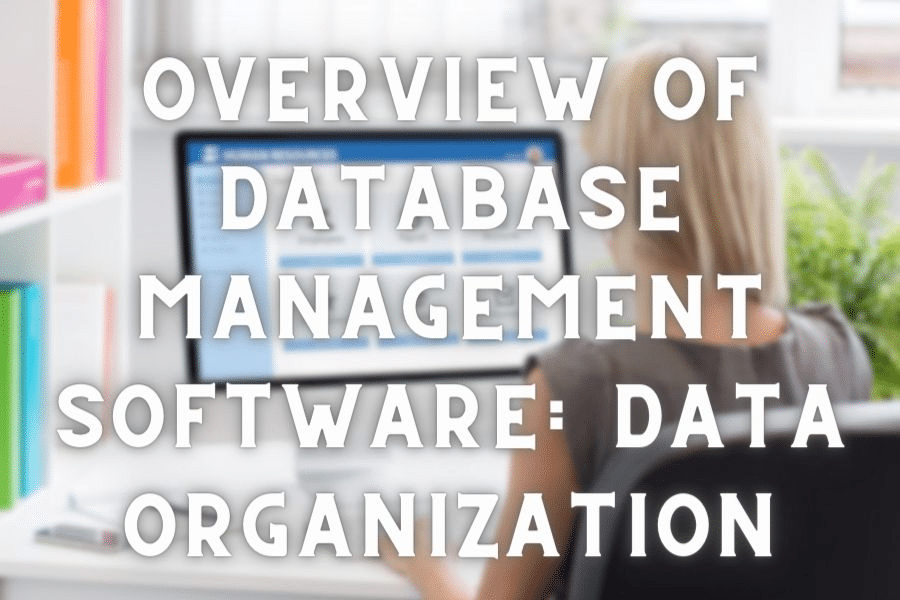Do you need help finding and organizing a lot of information? Do you find it harder and take more time to manage multiple databases? You’re not! As data grows, businesses and people need better ways to collect, organize, and maintain their databases.
We look at the popular database management systems, (DBMS) and the newest tools and techniques for improving how databases work. Our blog can help small business owners manage information about their customers. It will make big companies manage terabytes of data.
Problems with database management shouldn’t stop you. Join our blog about database management software to learn more today. We’ll get good at managing data to help you do well.
A DBMS is software that helps database administrators keep the data in a database organized and easily used. Users can add, change, and get information from a database and use different functions to manage and change the information.
DBMSs provide a way to store and organize data in an organized and efficient manner. This makes it easier for users to find information and manage it. Also, they make sure that data is safe and secure, that it is backed up, and that it can be brought back if it is lost or damaged.
DBMSs let multiple users and many people access the same data simultaneously without getting in each other’s way or messing up the data.
Data organization is how information is set up and saved in a database management system. (DBMS). It is an integral part of a DBMS because it controls how data is viewed, retrieved, and changed.
There are different ways to organize data; each has its own benefits and is best for specific uses. In this piece, we’ll talk about hierarchical, network, relational, and object-oriented data organization.
Hierarchical In a hierarchical data organization plan, the data is set up in a tree-like structure with parent-child ties. Each parent record can have more than one child record, but each can only have one parent record. This model works well for showing facts with clear one-to-many links.
Network The network data organization paradigm goes beyond the hierarchical method. You can do it by letting more complicated connections between data entities. In this model, a child could have more than one father. This makes a structure that looks like a web. This idea is used by systems that book flights and social networks that need to show links.
Relational The relational data organization model is based on tables, in which rows and columns are used to organize data. Each row is a unique record, and each column shows something about that record. Using primary and foreign keys, you can set up relationships between tables. This model is used a lot because it can be changed easily, is easy to use, and can handle complicated queries and data manipulation.
Object-oriented The object-oriented data organization approach combines the ideas of object-oriented programming with database management. In this model, data is represented as objects. Object properties and methods are used to set up connections between things. This model is perfect for apps that need complex data structures, like multimedia databases or computer-aided design (CAD) systems.
By knowing about these different ways to manage databases organize data, businesses can choose the DBMS that best fits their needs, ensuring that data is managed well and that performance is at its best.
Features of Database Management Software for Data Organization The features of Database Management Software (DBMS) make it easier to organize and handle data. With these features, businesses can store, access, and change their info more efficiently. In this section, we’ll talk about five essential parts of DBMS for organizing data:
CRUD Operations (Create, Read, Update, Delete) The main things that a DBMS does are called CRUD processes. Users can add new records, read and change current forms, and delete or add records as needed. These steps are the foundation of data manipulation and are required to ensure the data in a database is correct and uniform.
Querying and Reporting A DBMS’s search and analysis functions make it easier to find and look at data. Complex searches can sort, filter, and group data based on specific criteria . DBMSs also let users create reports, charts, and dashboards to look at data findings and share them.
Data Backup and Recovery Features like backup and recovery protect the data of a company. An affordable database management system (DBMS) lets you quickly back up your business data.
You can get it back if your computer crashes, you lose data, or something goes wrong. These features protect data and reduce downtime which could be very bad.
Security Features DBMSs have several security features that stop unwanted users from getting to, changing, or sharing sensitive data. Data in a database is kept safe with encryption, hiding, and leak detection. Data safety makes sure that companies follow industry rules. It can protect their brands, and keep customers’ trust.
User view and Permissions A DBMS lets the people in charge of the system decide who can see the data and what they can do with it. This makes sure that only people with permission to export data can do it.
This is done with role-based access control, which gives each person a job and a set of permissions. By limiting who can access sensitive data, businesses can lower the risk of data breaches and stay in line with data security laws.
These parts of Database Management Software are essential for organizing and managing data. They help businesses store, access, and change their data effectively to make better decisions and be more productive overall.
Examples of popular Database Management Software for Data Organization Each database engine has its features and benefits for organizing info. In this section, we’ll talk about Oracle, Microsoft SQL Server, MySQL, MongoDB, and PostgreSQL, all famous DBMSs that meet different needs.
Oracle Oracle Corporation makes Oracle Database a strong DBMS for big businesses. It is an RDBMS, scalable, stable, and full of features. Many big companies use Oracle for transaction processing, data warehousing, and mixed workloads.
Microsoft SQL Server It is a well-known database management system from Microsoft. (RDBMS). It is designed to handle various data management jobs, such as transaction processing, business information, and data analytics. SQL Server is very common because it is easy to use, works well with other Microsoft tools, and keeps data safe.
MySQL It is an open-source RDBMS that Oracle owns. It is often used for web-based apps and is known to be easy to use, fast, and flexible. MySQL is often the best choice for small to medium-sized businesses. It works with a wide range of computer languages, which makes it a flexible option for developers.
MongoDB A famous document-based NoSQL database. It works well and grows in a horizontal direction. It can handle a lot of random or partially structured data. The freedom of MongoDB makes it useful for content management systems, real-time apps, and apps that analyze large amounts of data.
PostgreSQL It is an open-source ORDBMS that is trustworthy, flexible, and works with SQL. It can handle both geographic data and other types of advanced data. PostgreSQL is used in complex systems with good data integrity and speed.
These examples of popular Database Management Software for organizing data fit a wide range of needs and use cases, so businesses can pick the one that works best for them. By choosing the right DBMS, organizations can make it easier to manage their data and make better choices based on the data.
Advantages of Using Database Management Software for Data Organization Using Database Management Software (DBMS) to organize data has many perks. It can affect how efficient, productive, and good at making decisions a company is. In this section, we’ll talk about the four main benefits of using a DBMS to organize data:
Improved Data Accuracy and Consistency A DBMS helps keep data accurate and consistent by offering a centralized data storage solution. It also lowers data redundancy and enforces data integrity constraints. This ensures that the information in the database is accurate and up-to-date, reducing the chance of mistakes and bad choices.
Increased Productivity A DBMS increases productivity by simplifying data management processes and automating repetitive chores like data entry and report generation. Employees can quickly get to and change data, which gives them more time to work on more important jobs. This increased efficiency directly contributes to the success and growth of a company.
Better data security A DBMS has several security features that keep private data from being hacked or accessed by people who shouldn’t be able to. These features include encryption, data masking, ways to find intrusions, and access rules based on roles. A DBMS helps businesses stay aligned with industry regulations and build trust with customers and stakeholders by ensuring safe data.
Better Decisions A DBMS makes making decisions based on data easier by giving you robust searching and reporting tools. Users can quickly get, look at, and see data, which helps them find trends, patterns, and insights that help them make strategic choices. When organizations have access to accurate and consistent data, they can make choices that support their operations and have them more competitive in the market.
In short, using Database Management Software to organize data has several benefits that help a company be more efficient, productive, and able to make good decisions. By using a DBMS, companies can improve their data management and succeed in a world that is becoming more data-driven.
Challenges of Database Management Software for Data Organization Database Management Software (DBMS) manages data. Still, it has a lot of problems that businesses need to fix to be as efficient as possible. It takes work to set up, personalize, and improve a DBMS.
Hiring experts or training workers takes time and money. Data safety and following GDPR and HIPAA are also problems. Organizations must follow these rules and keep private data safe to avoid data breaches. Businesses need a DBMS that can keep up with how much data they need to store and how fast they need to handle it.
Lastly, companies must be careful when choosing a DBMS for their use cases. This is because different uses need different kinds of database systems. Companies can get the most out of their DBMS data organization by addressing these problems. It can improve their efficiency, productivity, and ability to make decisions.
Future of DBMS As technology and business need to change, database management software (DBMS) may become more exciting and valuable. The way DBMS work will change because of AI and machine learning. It will be easier for users to make changes and fine-tune networks independently. This will help with speed, using resources well, and doing work by hand.
IoT apps and remote processes can process and analyze data in real-time. More and more systems will be able to handle relational, graph, and document data models. Data safety, privacy, and compliance will always be important because rules change, and hacks worsen.
Lastly, green DBMS operating systems will be made possible by focusing on sustainability and energy economy in data centers. It makes it easy to store and manage data and is better for the environment at the same time.
Ultimately, DBMS will change how businesses manage, process, and use data. It may open up new possibilities for growth and innovation.
Frequently Asked Questions What is the overview of the database development process? There are eight steps to making a database. The steps are planning, gathering requirements, conceptual design, logical design, physical design, building the database schema, implementing, deploying, and providing ongoing support.
What is database management software, for example? What does the acronym DBMS mean? Database Management Tools (DBMS) are software programs used to store, collect, and run queries on data. A DBMS connects the end-user interface to the database. Users can add, change, remove, and read information from the database.
Is DBMS free? There are free and paid DBMSs. Open-source DBMSs include MySQL, PostgreSQL, and SQLite. Open-source DBMSs have a lot of help. Online groups and tools give information and support.
There may need to be more help, features, or speed with free DBMSs. Corporate DBMSs like Oracle and Microsoft SQL Server cost more, but they have more features, are faster, and have better support. The DBMS programs Oracle Express Edition and Microsoft SQL Server Express are free or inexpensive. Due to a lack of resources, features, or scaling, these versions are meant for small-scale use or learning.
DBMS should be chosen based on the organization’s goals, funds, and technical knowledge. Businesses have to consider the pros and cons of free and paid DBMSs before deciding which one to use.
Final Thoughts This blog post should have helped you understand how database management systems change constantly. You can organize, maintain, and manage your data with the right software. It can make better decisions, improve efficiency, and get the most out of your own database system.
When comparing database management software, you should consider your organization’s needs and how it can grow. You need to know what its current and future needs are. The right software will save you time and money and help you grow your business by letting you make decisions based on data.
Browse more on our site to learn more about the software solutions we offer. We give expert reviews, comparisons, and tips to help you choose the right product. Keep in mind that it is easy to manage a database. Use this chance to learn how to collect data. Visit our site now!



